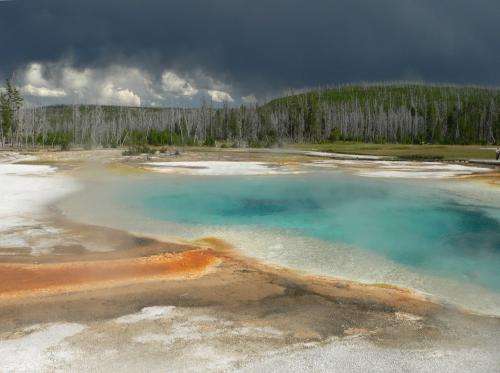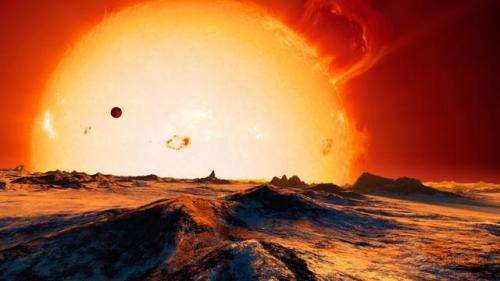Astro-virology

In HG Wells' 'The War of the Worlds', the invading Martians were beaten by that most unassuming of combatants – the common cold. Could the reverse happen and alien viruses pose a threat to human astronauts when they land on Mars? This intriguing question is asked by Dale Griffin in a new paper for the journal Astrobiology, who also asks whether our first evidence of extraterrestrial life could come in the shape of viruses.
Biologists do not consider viruses to be alive. They are smaller than bacteria (20-300 nanometers compared to 500-1500 nanometers) and cannot replicate on their own - instead they must invade a host cell and use its genetic tools to aid its replication. Yet viruses completely dominate the planet - hypochondriacs might tremble at the fact that there are ten million trillion trillion viruses existing on Earth right now, with a tenth of them found in the oceans. Given their total dependence on cellular life in order for them to replicate, it is little surprise that wherever life is found on our planet, viruses are right there with them.
Griffin, a microbiologist at the US Geological Survey at St Petersburg in Florida, thinks that we can expect to find a similar situation where life exists on other planets. "I would think that the evolution of cellular life on another planet would be very similar to what occurred on Earth," he says. "If this is the case and cellular life is present on any given planetary body then I would expect viruses to also be present in superior numbers."
Yet he doesn't believe that astrobiologists have fully cottoned onto this fact and that exo-viruses are just as viable a topic for speculative study as extraterrestrial cellular life. The reason for this may be partly because the study of viruses on Earth beyond those that cause illness in humans and animals has really only taken off in the last decade or so. As Stedman alludes to, studying viruses is not easy.
"It is only recently in the historical microbiology record that we've had the molecular tools that have allowed us to determine the number and the extent of the diversity of viruses on Earth," says Griffin. Part of the problem is that viruses on Earth have for the most part evolved symbiotic relationships with specific hosts - it's the reason you usually cannot catch a cold from a dog, for example, as the viruses that cause colds in dogs have developed to work with canine cells, and vice versa. So to really study viruses in detail one must culture a host cell, usually a bacterium, in the laboratory and for many viruses we have not identified their host(s). This has slowed research into the vast range and diversity of viruses on Earth considerably. Says Professor Chris Impey of the University of Arizona, who has written several books on astrobiology, "Because of the difficulty of culturing most bacterial species, we're still ignorant of the full range of symbiotic relationships between bacteria and viruses."
Now that things are changing, Griffin thinks it is time to consider extraterrestrial viruses. Stedman agrees. "Life on Earth is clearly heavily influenced by viruses," he says. "The jury is still out on whether viruses are essential for life, but certainly life on Earth would be very different without viruses. Finding life in the absence of viruses would surprise me, but would be very interesting."

The key point, Griffin argues, isn't that viruses will exist where life also exists, as we will have noticed that life long before we find the accompanying viruses, but rather that multiple host types of viruses could be found at both the beginning and the end stages of life on a planet.
Nobody really knows when viruses first developed on Earth, but the smart money suggests they are very ancient and could even have given evolution the required push towards cellularity. When a virus invades a cell, it brings with it its own genetic material and can add it to the cell's genome. When the virus replicates inside the cell, it takes some of the cell's genetic information with it, transferring it from cell to cell, organism to organism. Hence genes are swapped around, driving evolution.
Of course, viruses can cause damage but they can also bring benefits to the cell. For instance, if the cell has been damaged by ultraviolet light, a virus carrying ultraviolet-resistant genes can introduce those genes to the damaged cell, helping it to repair. Vice-versa, damaged viruses can have their replicating abilities restored if a cell is infected by multiple viruses that swap enough genetic information to produce a complete undamaged viral genome.
This makes viruses extremely hardy. "Viruses are robust and adaptable and they may be able to survive a long time in a dormant state," says Impey. Although viruses are inert outside of host cells, on Earth they have been seen to survive in extreme conditions. For example, viruses have been found in hot spring water in Yellowstone National Park in temperatures reaching 93 degrees Celsius. Conversely, viruses have been discovered in briny sea-water at minus 12 degrees Celsius, while the influenza virus is stored in secure laboratories at temperatures as low as minus 70 degrees, with no apparent damage to the virus itself. Nor do they require water to survive outside of the cell – they simply remain inert down and assuming no damage from radiation for example, they just re-awaken when they invade a new cell.
What happens however on a planet where all life has long ago disappeared? This may be the case for Mars, although it remains to be seen whether life did ever exist in the brief warm and wet periods of the red planet's ancient history. Let us suppose that Mars did once harbor primitive microbial life, with the requisite viruses accompanying it. As we have seen, on Earth most viruses are host specific – Griffin argues that the same would hold for extraterrestrial viruses too. However, when Martian life died off, or at least became rare, viruses would have been faced with a problem. If they remained host specific, they would disappear along with their hosts. If, however, the adapted and became generalized they could inhabit whatever cells they came across, sharing genetic information to survive at a subsistence level.
As such, if there was once life on Mars, today all that may be left could be the generalized viruses, capable of infecting most cells they come across. These viruses could therefore present a biohazard for any future astronauts that land on Mars and perhaps while we are looking for life on Mars, we should also equip our robotic rovers to search for viruses too.

Griffin has some ideas about how we may begin searching for extraterrestrial viruses. One tool would be a MEMS-based concentrator [Micro-Electro-Mechanical Systems] which is a micron-sized technology that can be used in chromatography [the separating of mixtures in a laboratory setting] and spectroscopy techniques. This could be used in conjunction with particle-sized separators, microscopic imaging systems and nucleic sequencers to sift through the Martian dirt and analyze it for virus-like structures and nucleics.
"This approach would allow you to screen samples for cellular life, to image any virus-like particles or cells that may be present - are they similar to known variants on Earth? - and to sequence segments of their genome if it is structurally similar to our own, i.e. RNA or DNA," says Griffin.
There is one other location in the Solar System where viruses could remain the last holdout of organic entities, but it is only to be found in the far future, two billion years hence when our Sun has brightened. At this time Earth would have warmed, the plants withered and died, the oceans boiled away and life all but eradicated. Even here, in this smoldering world, viruses could remain. With little cellular material remaining the viruses could evolve to share genes altruistically, regardless of the host. As such, suggests Griffin, altruism in the microbial world may be the last state of life to be found on our planet, before the Sun grows so hot that even the viruses are snuffed out. Viruses and cells working in unison at the beginning and end of life stages on our planet – with billions of years of competitive conflict in between.
In the meantime, research into exo-viruses could be the seed for a new revolution in astrobiology. "The biological research community will continue to refine our understanding of viruses," says Impey. "Meanwhile, it is useful to start seriously considering their role in the wider landscape of exobiology. Griffin's excellent paper is a good starting point."
Journal information: Astrobiology
Provided by Astrobio.net

















